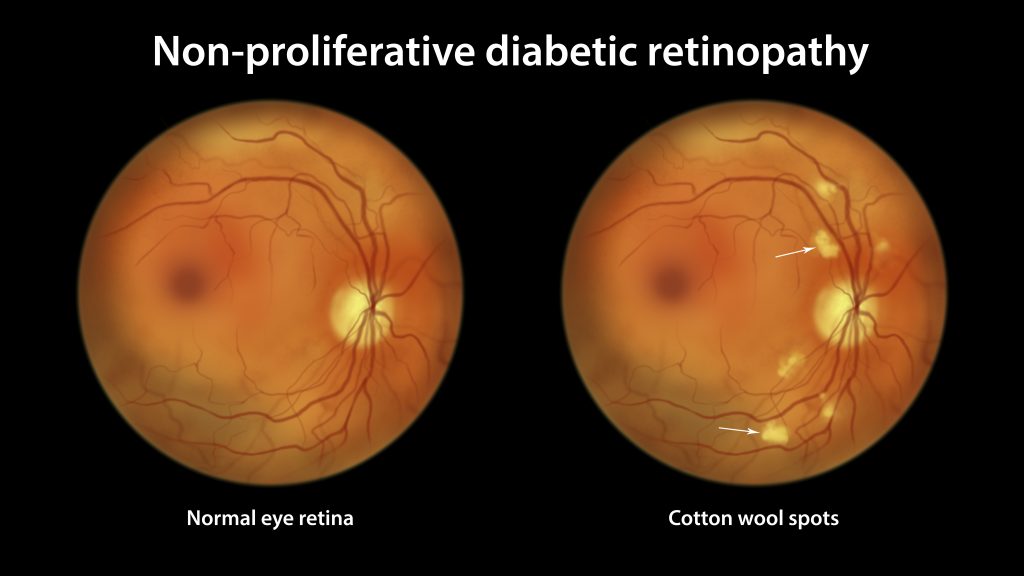Diabetic Retinopathy occurs when blood vessels in the eye are damaged as a result of high blood glucose levels and disease progression can occur rapidly. Untreated, it can significantly impair a person’s vision, especially their central vision.
Early signs of this condition include changes in vision, red or blue-yellow halos around lights, blind spots, wavy lines, or blurred vision. If left untreated for an extended period of time, there may be permanent damage to the retina and optic nerve. There are two types of diabetic retinopathy: non-proliferative and proliferative. With the help of your eye doctor, you can detect these stages early on and take action before they worsen and cause long-term vision problems.
What Is Diabetic Retinopathy
It is a disease of the retina, the light-sensitive tissue at the back of the eye that is responsible for converting light signals into electrical impulses that travel through the optic nerve to the brain.
This occurs when high blood sugar levels damage the small blood vessels that nourish the retina. Retinopathy can lead to blindness if it isn’t treated.
Early detection and treatment is imperative when it comes to preventing blindness from retinopathy. The retina is divided into two parts: the blood vessels and the light-sensing cells called the rods and cones. In people with diabetes, blood vessels may swell, rupture, and leak blood or fluid into the retina. This can interrupt the flow of nutrients and oxygen to the retina. Retinal cells may then die, causing the retina to thicken or swell from the inside out. When this happens, the retina may detach from the back of the eye and cause sudden vision loss.
View VideoNon-proliferative diabetic retinopathy
Non-proliferative diabetic retinopathy (NPDR) is the mildest form of diabetic retinopathy.
Retinal vessels become thickened, brittle, and/or narrowed, and may progress to the more severe type of the condition. It is estimated that up to 45% of people with diabetes have some stage of non-proliferative retinopathy. Symptoms include blurred vision, black spots or floaters, or other visual changes. There is no treatment for non-proliferative retinopathy, although some medications may help slow down the progression to proliferative retinopathy.

Proliferative diabetic retinopathy
Proliferative retinopathy is a complication of diabetes that can lead to blindness if left untreated. It is a form of diabetic eye disease that causes the blood vessels in the retina to grow abnormally large, often causing blood clots to form in the eye.
This is a complication of diabetes that occurs when blood sugar levels are consistently elevated. Your retina is a light-sensitive layer of tissue at the back of your eye that receives images and converts them into impulses your brain can understand. Prolonged high blood sugar levels cause damage to the small blood vessels in the retina. Symptoms of proliferative retinopathy include difficulty driving at night, flashing lights appear too bright, swelling of the retina, and vision loss.
View VideoSymptoms of Diabetic Retinopathy
In the early stages, diabetic retinopathy may not cause any noticeable symptoms. However, as the condition progresses, patients may experience:
- Blurred or distorted vision
- Difficulty seeing in low light conditions
- The appearance of floaters or spots in their vision
- Gradual loss of vision
If you experience any of these symptoms, it is important to schedule an appointment with an ophthalmologist as soon as possible.
Causes of Diabetic Retinopathy
The primary cause of diabetic retinopathy is high blood glucose levels. Over time, high glucose levels can damage the blood vessels that supply the retina with oxygen and nutrients, leading to retinal damage. Other factors that may contribute to the development of diabetic retinopathy include:
- High blood pressure
- High cholesterol
- Smoking
- Pregnancy
- Obesity
Retinopathy Treatment
If you have non-proliferative diabetic retinopathy (NPDR), you may be given a series of eye injections that could help to slow down the progression to proliferative DR.
These injections help stop the growth of new abnormal blood vessels and replace old ones with new, normal vessels. If you have proliferative diabetic retinopathy, you may need more intensive treatment that could slow down the progression to blindness. Treatment could include surgery, diabetic retinal acuity surgery (DRAE), or vitrectomy surgery. There are several medications that could be given to help slow down the progression of the condition. Please consult your eye specialist regarding these medications.
View Video
